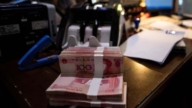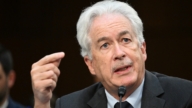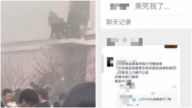【新唐人2011年7月2日訊】中國大陸持續通膨引發的高物價令公眾不滿,而網友微博發佈的中美消費及物價對比更令人詫異:在美國消費和購買產品比中國還要便宜的多!這條帖文流傳甚廣並引起廣泛的共鳴。學者表示,中國比美國物價高的根本原因是由中共的貨幣政策、高稅收政策和內部的高通膨所致。
這條微博寫道:中國,工資5,000元,吃一次肯德基30元,下一次館子最少100元,買條Levis牛仔褲400元,買輛車最少30,000元——夏利﹔美國,工資5,000美元,吃一次肯德基4美元,下一次館子40美元,買條Levis牛仔褲20美元,買輛車最多30,000美元——寶馬。
旅美經濟學家簡天倫表示,貨幣政策和財政政策是導致中國商品價格比美國貴的主要原因。
簡天倫:“賣地也好、投資也好,大量貨幣供應低估人民幣,這三個都可以知道中國的貨幣發行量來源在哪裏,為甚麼市場上那麼有錢,所以價格就必然高。歸結起來,這三個政策是推高價格的一個原因。”
簡天倫表示,隨著大量投資、銀行貸款的急速增長,市場上貨幣量也大量增加﹔加上近年來地方的土地財政,出售土地佔據GDP總量的1/3以上,地方政府貸款大量增加,2010年底,地方政府債務已達到10.7萬億﹔另外,國家以出口拉動內需為戰略、低估人民幣的方針,導致外匯大量增加,因此,致使人民幣發放大量增加。簡天倫說,現在中國貨幣供應量已經超過美國,成為世界第一。
而經濟時政評論家草庵居士認為,中國印的鈔票越來越多,人民幣越來越多,通貨膨脹會越嚴重,所以中國經濟發展不可持續性。
草庵居士:“所以你看到中國發展經濟不要以為現在中國經濟很好,你看到好是因為把全國百姓的財富政府拿到手裡頭,但實際上內部是靠通貨膨脹的,因為它的鈔票印的越來越多,而且物資越來越少,這是一個惡性循環。在這種情況下中國現在給大家看到我們在美國的物價相反要比中國便宜。”
去年,大陸知名財經評論人士時寒冰到美國旅行,特別對中美物價的差別進行了半個月的走訪,時寒冰最終的調查結果是:除非涉及到人工服務,比如理髮,或涉及智慧財產權的圖書音像外,美國商品的價格普遍低於國內,比中國便宜50%以上,而美國的人均收入是中國的34倍。
時寒冰在他的博客表示,GDP遠不及美國的中國,同樣的商品在中國所對應的貨幣量,遠遠大於在美國所對應的貨幣量!關於這點,簡天倫認為,高稅收的財政政策是另一個主要原因。
簡天倫:“中國20年來 GDP增長很高,但是財政更高,都在20%以上的增長速度,自然是稅收非常高。雖然中國生產的產品(價格)並不一定貴,但是中國的財政稅收太厲害了,把成本完全提上去了,最終端的價格裡面,50%甚至70%都跟稅收有關。這就解釋了為甚麼中國製造的產品在中國反而比美國貴得多。
依據國際貨幣基金組織《政府財政統計年鑑(2007)》公布的2006年資料計算,中國商品中所含的稅比任何一個發達國家都高:是美國的4.17倍,是日本的3.76倍,是歐盟15國的2.33倍。
新唐人記者高紫檀、宋風、孫寧採訪報導。
Why Prices in China are higher than in U.S.
The public is discontent with the inflation in China.
It is even more surprising to the Chinese that
many consumer goods are cheaper in the U.S.
Scholars say that the higher prices in China
were caused by Chinese Communist Party’s (CCP)
monetary policy, tax policy and high internal inflation.
A blog reveals that, with a salary of RMB 5,000
it costs RMB 30 to have a meal at KFC in China,
over RMB 100 for a meal in a restaurant,
RMB 400 for a pair of Levi’s jeans,
and over RMB 30,000 for the cheapest car Xiali.
In the U.S., with a salary of USD 5,000,
it costs 4 dollars for a KFC meal,
40 dollars for a meal in a restaurant,
20 dollars for a pair of Levi’s jeans,
and less than USD 30,000 for a BMW.
U.S.-based Economist Jian Tianlun said the differences
are caused by China’s monetary and fiscal policies.
Jian Tianlun: Due to land sales, investments
and a large monetary supply, RMB deprecates,
and China’s currency issuance volume is large.
The large monetary supply caused price increases.
Jian says that with lots of investments,
and the rapid growth of bank loans,
the monetary supply dramatically increases.
Combined with the recent regional land finances,
land sales account for a third of China’s GDP.
Regional government debts increased drastically
and reached RMB 10.7 trillion by the end of 2010.
Also, the current policy of stimulating domestic demand
by exports and of keeping the RMB exchange rate low.
It caused a large increase in foreign exchange reserve,
which in turn increased China’s monetary supply.
Jian says China’s money supply ranks the first globally.
Economic Critic Caoan Jushi believes that
as China keeps on printing more and more bills,
it makes the inflation more serious. Therefore,
China’s economic development is not sustainable.
Caoan Jushi: China’s economic development seems
to be good, but it is not the case.
The government robs the people’s money.
There is a high internal inflation.
As more bills are printed, with diminishing goods,
it forms a vicious circle. As a result,
product prices are higher in China than in the U.S.
Chinese financial critic Shi Hanbing made a trip
to the U.S. to compare the price differences.
His conclusion is that except for services and
intellectual property-related products,
goods in the U.S. are 50% cheaper than in China.
However, U.S. per capita income is 34 times
of the per capita income in China.
Shi blogged that China has a lower GDP than the U.S.
However, more money is needed in China
to buy the same products than in the U.S.
Jian attributes this to high-tax fiscal policy in China.
Jian: China had a high GDP growth rate in last 20 years.
However, it had a higher fiscal budge growth rate
of at least 20%. As a result, the tax rate became high.
The goods made in China may not be expensive,
but the taxes imposed increase their prices drastically.
50~70% of the end price is related to taxes.
This explains why Chinese-made products
have higher prices in China than in the U.S.
Data from the IMF Government Finance Statistic
shows that (based on data in 2006)
China had the large portion of tax as part of the price.
It is 4.17 times of the U.S. figure,
3.76 times of the Japanese figure
and 2.33 times of the 15 E.U. countries.
NTD reporters Gao Zitan,Song Feng and Sun Ning
























